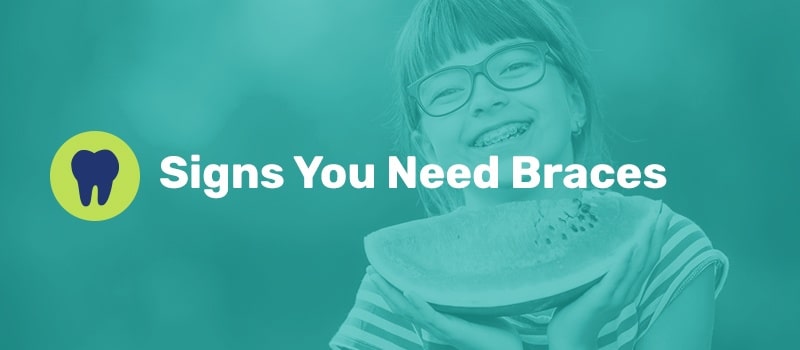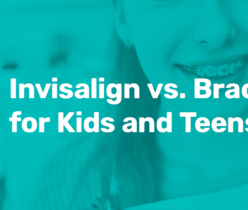If your child requires Invisalign or braces, they’re not alone. Almost 75% of all teens and children have some type of dental problem where they’ll require orthodontic care.
When you first notice your child has crooked permanent teeth coming in, you may begin wondering if they’ll need braces. If they do, you’ll be happy to know there have been considerable advancements with orthodontic treatment, providing your child with more choices. Anyone who has had braces knows they work. But, the question here is, “Does my kid really need braces?” Read on to find out signs your kid needs braces.
Does My Child Really Need Braces?
Whether you’re a parent concerned about your child’s teeth or a teenager asking yourself, “How do I know if I need braces?” consider some of the benefits.
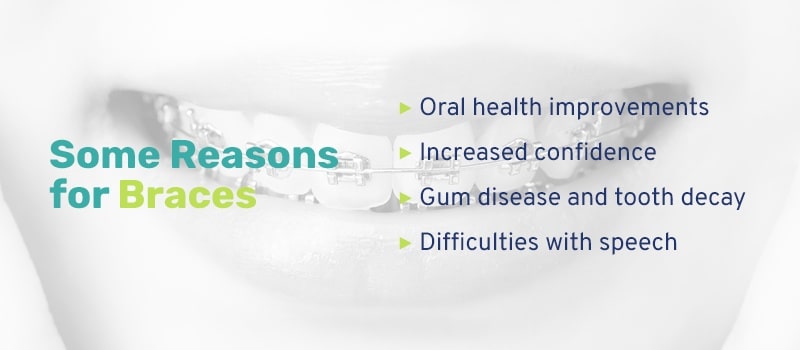
Aside from the aesthetic advantages of braces, here are some other reasons for braces:
- Oral health improvements: Braces can help correct problems like a misaligned bite, which causes abnormal and hazardous stress on certain teeth and areas of your mouth. This can lead to weakened teeth, which become susceptible to breaking and chipping — and that can cause irreversible problems.
- Increased confidence: When your child’s teeth are straight and beautiful, it can increase their self-esteem and confidence.
- Tooth decay and gum disease: It can be difficult for your child to brush crowded teeth or overlapping, crooked teeth effectively. This causes bacteria to build up, which can lead to tooth decay and gum disease. Straight teeth are easier to clean.
- Difficulties with speech: When teeth lean too far backward or forward or are out of line, it can affect speech patterns, causing frustration and embarrassment for your child. Braces adjust the position of your child’s teeth and set them up for the ability to have clear speech. Of course, depending on the cause of the problem, a speech specialist may need to be involved too.
These are only some of the many benefits of braces. But, when are braces needed?
How to Choose a Local Orthodontist
How to Know If Your Child Needs Braces
The best age for children to get braces varies from child to child. Typically, orthodontic treatment starts when a child is between 8 and 14 years old because children in this age range have some or all of their permanent teeth.
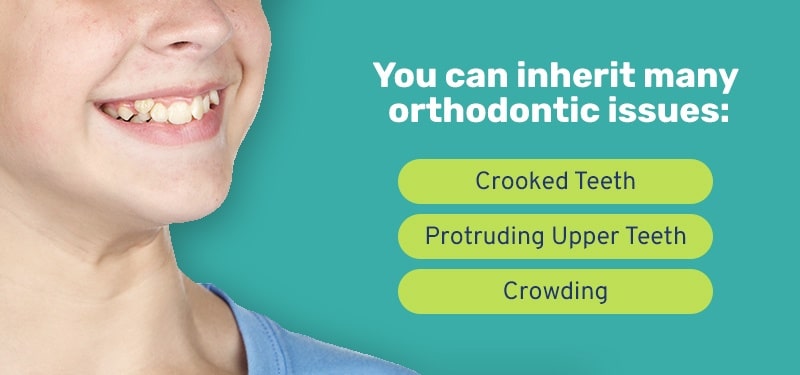
You can inherit many orthodontic issues like crooked teeth, protruding upper teeth or crowding. Some issues develop over time when kids:
- Breathe through their mouths
- Suck their fingers or thumbs
- Have poor nutrition
- Have poor oral hygiene
- Have other problems
Even if the orthodontist finds an issue, they might not recommend immediate orthodontic treatment. Many prefer to take the “wait-and-see” approach.
However, this doesn’t mean there aren’t good reasons for opting to move forward with braces even though your child is a teen or in pre-puberty. If your child has finished growing or doesn’t feel comfortable with how their teeth look, orthodontic treatment could be the answer.
Your routine dentist is the perfect resource for helping you decide if your child, no matter what their age is, would benefit from making an appointment with an orthodontist. Still, it’s helpful to know when braces are needed. And you don’t need a referral or recommendation from a dentist to see an orthodontist.
What Is the Best Age to Get Braces for a Child?
Your child’s age might determine when to get braces, but some children mature more slowly than others, including how long it takes for their permanent teeth to come in. Most orthodontists recommend a child should be at least 7 years old before starting orthodontic treatment, with the ideal age range between 11 and 14 years old. The jawbone is still developing when your child is this young, making the job of shifting teeth and correcting bite problems slightly easier and less complicated compared to treating an adult’s teeth.
For adolescent full orthodontic treatment, it’s best to wait for the child to have a full set of permanent teeth, or at least most of them, for the treatment to be effective. Braces will shift the positions of your child’s new permanent teeth. The treatment required can be more difficult to predict while the teeth are erupting or when your child still has baby teeth.
Even if your orthodontist is unable to work on your child’s teeth right away, many dental health professionals recommend children get an evaluation when they are younger. At around age 7, your child can have their teeth checked for possible issues that will need to be addressed with braces. The orthodontist might be able to estimate how long your child will require treatment once they do get started.
Common Signs Your Child Needs Braces
So, how do you know if you need braces? What are the signs your child needs braces?
There are many reasons why we need braces. If your child is experiencing any of the following problems, it might be time to make that appointment with an orthodontist for an evaluation. At Sprout Pediatric Dentistry & Orthodontics, we provide personalized services to tailor a treatment plan that’s right for your child. Some issues that could indicate it’s time for braces are:
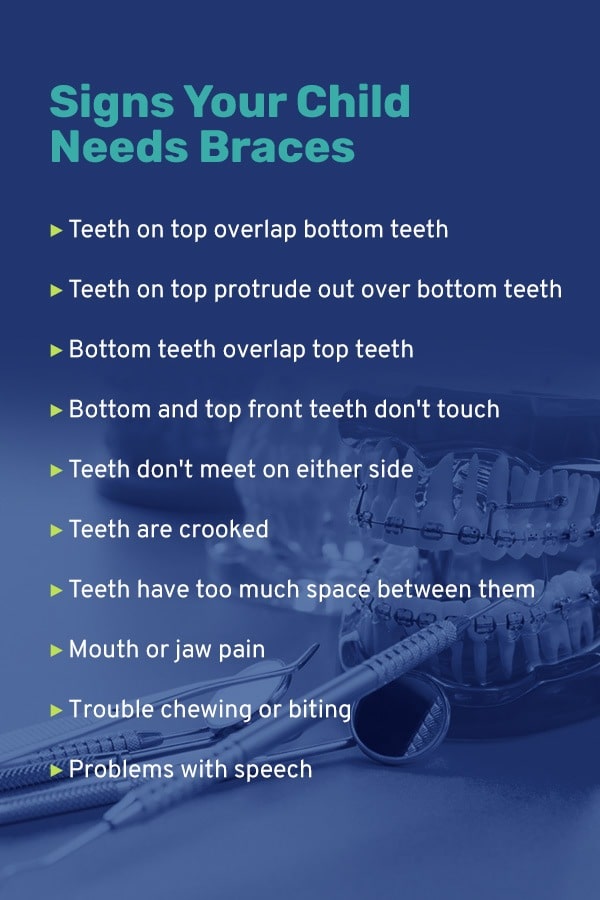
- Teeth on top overlap bottom teeth: It’s normal to have somewhat of an overbite where your teeth on top overlap your bottom teeth slightly. However, if you notice when your child bites down, you can’t see much of their lower teeth, this means they have an extensive overbite that could cause dental problems. You should have an extensive overbite corrected to prevent premature tooth wear.
- Teeth on top protrude out over bottom teeth: If your child’s upper teeth jet out significantly over their bottom teeth, it’s referred to as an overjet. Extensive overjet can lead to trauma to their upper front teeth, usually from falling or getting hit in the face, because they take the impact first. You can have this corrected with braces and rubber bands. For more serious cases, the dentist may recommend extractions or surgery to align your child’s bite and jaws.
- Bottom teeth overlap top teeth: Referred to as an underbite, orthodontists treat this type of bite similar to the way they do an overbite — they align your teeth or jaws.
- Bottom and top front teeth don’t touch: Open bites could make it hard to chew or bite foods and could affect your child’s speech. Open bites, while sometimes genetic, could also be due to prolonged pacifier use or thumb-sucking.
- Teeth don’t meet on either side: If your child’s bottom and top teeth on the sides of their mouth don’t line up when they close their mouth, they could have a crossbite. This could cause their teeth to unevenly wear. Dentists fix crossbites by aligning the jaws or teeth, depending on what caused them.
- Teeth are crooked: Crooked teeth are possibly the most common reason individuals visit an orthodontist and is usually what comes to mind when you hear a person is getting braces. There are a variety of reasons your child’s teeth can grow in crooked, such as if their permanent teeth grow in around baby teeth that haven’t fallen out yet or if their jaw isn’t yet large enough to accommodate their adult teeth. Regardless of the reason, crowded or crooked teeth can prevent children from cleaning their teeth properly and could make them self-conscious. Traditional braces or Invisalign can easily move crooked teeth back into place.
- Teeth have too much space between them: This is the opposite issue of crowded teeth, but still can cause problems and is still extremely treatable with Invisalign or braces.
- Mouth or jaw pain: You may not see all orthodontic problems — some your child may only feel — but that doesn’t mean they’re any less significant. If your child is experiencing mouth or jaw pain regularly, there may be an underlying orthodontic reason and in addition to consulting with their dentist, they should see an orthodontist to determine what’s causing their discomfort.
- Trouble chewing or biting: Misaligned teeth can negatively impact your child’s ability to eat comfortably. If your child is having problems while trying to eat or bites their tongue or the inside of their cheeks frequently, their bite could be misaligned, or their teeth might be crooked.
- Speech problems: Misaligned teeth can sometimes affect your child’s pronunciation and air control. If your child mispronounces certain words or struggles generally with speech, an orthodontist might be able to work alongside a speech pathologist.
What Are Some Alternatives for Braces?
You might want to know if your child has to get braces, especially when you would rather avoid this option if possible. If your child has a bite alignment problem or crooked teeth, it’s best to pursue treatment options that can correct their teeth before they grow older. Below are some alternatives to braces:
- Headgear: Orthodontic devices worn on the outside of your child’s mouth can correct severe bite problems without straightening the teeth. To move individual teeth into alignment, headgear may be used in combination with another treatment.
- Retainers: This treatment can be prescribed for children after they complete a treatment course with braces. If your child’s teeth are only mildly crooked, an orthodontist might agree to make a set of retainers instead of braces.
- Veneers: Used to mask crooked teeth, veneers alter the appearance of your child’s smile without straightening the teeth.
- Clear aligners: Instead of traditional braces, your child might be a good candidate for clear aligners such as Invisalign. The aligners can be removed just like retainers but must be worn for most hours of the day and night.
Do You Need Braces Quiz
Some children can’t wait for braces, considering them as a sign they’re reaching their teen years. Others, however, may worry about what the braces will look like or how they’ll feel.
No matter how your child feels, you likely have some concerns or questions of your own about braces.
Below are some questions that can help you determine if your child does indeed need braces. However, adults can also require orthodontic treatment. So, if you’re an adult or teenager wondering if you should get braces, take our “Do I Need Braces?” quiz!
1. Do You Have an Overbite?
- Yes, I have a small overbite.
- Yes, I have a severe overbite.
- No, I’m not aware of any overbite.
- My bite is normal.
2. Do You Have an Underbite?
- Yes, I have a small underbite.
- Yes, I have a severe underbite.
- No, I’m not aware of any underbite.
- My bite is normal.
3. Do You Have Crooked Teeth?
- Yes, I have severely crooked teeth.
- Yes, I have moderately crooked teeth.
- Yes, I have slightly crooked teeth.
- No, my teeth are completely straight.
4. Do You Have Crowded Teeth?
- Yes, I have severely crowded teeth.
- Yes, I have slightly crowded teeth.
- No, but I do have a gap.
- No, my teeth are perfectly spaced.
5. Do You Have Any Gaps Between Your Teeth?
- Yes, I have severe gaps between my teeth.
- Yes, I have slight gaps between my teeth.
- No, but my teeth are crowded.
- No, I don’t have any gaps between my teeth.
6. Is Your Jaw Misaligned?
- Yes, my teeth don’t line up.
- Yes, but I hardly notice it.
- No, I have a perfectly aligned jaw.
- I’m not certain.
7. Has a Dentist Referred You to an Orthodontist?
- Yes, my dentist has referred me to an orthodontist.
- Yes, my dentist has referred me to an orthodontist, but I don’t agree.
- No, but I think I should see an orthodontist.
- No, I have perfect teeth.
8. How Do Your Parents’ Teeth Look? (teens only)
- My parents have had orthodontic treatment.
- My parents haven’t had orthodontic treatment, but their teeth look great.
- My parents’ teeth are crowded, crooked, misaligned or have too many spaces.
- I’m not sure about my parents’ teeth.
9. Do You Experience Pain in Your Jaw When You Eat?
- Yes, I always experience pain in my jaw when eating.
- Yes, I sometimes experience pain in my jaw when eating.
- Yes, but I don’t believe I require orthodontic work.
- No, I don’t experience any pain in my jaw.
10. Did Your Baby Teeth Come out Sooner Than Your Peers’?
- Yes, some baby teeth came out sooner.
- Yes, all my baby teeth came out sooner.
- No, my baby teeth came out at the same time.
- No, my baby teeth came out later.
11. Does Your Jaw Make Sounds or Shift?
- Yes, but my jaw shifts only.
- Yes, but my jaw makes sounds only.
- Yes, my jaw does both.
- No, my jaw doesn’t make sounds or shift.
12. Do You Frequently Bite the Inside of Your Cheek Unintentionally?
- Yes, I sometimes bite the inside of my cheek.
- Yes, I frequently bite the inside of my cheek.
- No, I never bite the inside of my cheek.
- I haven’t noticed.
13. Is It Difficult for You to Chew Food?
- Yes, I sometimes find it difficult to chew food.
- Yes, I always find it difficult to chew food.
- No, I never find it difficult to chew food.
- Yes, but I don’t require orthodontic treatment.
14. Do Your Lower Teeth Touch the Roof of Your Mouth?
- Yes, my lower teeth sometimes touch the roof of my mouth.
- Yes, my lower teeth touch the roof of my mouth every time I close my mouth.
- No, my lower teeth never touch the roof of my mouth.
- I haven’t noticed.
15. Are You Happy With Your Smile?
- Yes, my smile is perfect.
- Yes, my smile could be better.
- No, but my smile isn’t too bad.
- No, I really dislike my smile.
Get a Professional Opinion
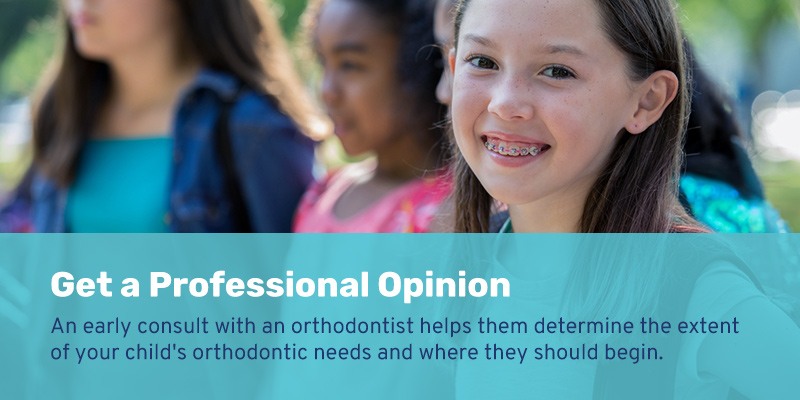
While some children have clear and obvious dental issues, like missing or crooked teeth, requiring orthodontic treatment, others might have dental problems that you can’t detect easily just by looking. Only an orthodontist or dentist can know for sure if your child requires braces.
An early consult with an orthodontist helps them determine the extent of your child’s orthodontic needs and where they should begin. The orthodontist will conduct a thorough exam and take X-rays and images of your child’s teeth and mouth.
After completing these two steps, they’ll provide a diagnosis and recommend an individualized treatment plan that will address the orthodontic needs of your child. They’ll also discuss the various teeth straightening options, including traditional braces or Invisalign, as well as costs, an estimated timeframe of treatment and insurance coverage.
They’ll also address any concerns or questions you have. Once you agree about which treatment plan is best for your child, their next appointment will involve setting up their clear aligners or braces.
Make a Consultation Appointment With Sprout Pediatric Dentistry & Orthodontics
At Sprout Pediatric Dentistry & Orthodontics, we offer both braces — ceramic and metal — and Invisalign clear aligners for adults, teenagers, and children. We care deeply about your child’s teeth. If you’re a teen struggling with how to tell if you need braces, come visit us at our office and bring your answers to the quiz above.
If you’re not sure whether your child requires braces, set up your first consultation for potential orthodontic treatment with our board-certified orthodontist, Dr. Paul Fox.
We provide a high level of education and training and compassionate care for both children and parents. We serve your children from infancy straight through to adolescence by offering high-quality dental care. Regardless of your child’s age, we have the expertise and skills to address their specific needs.

A Portland native, Dr. Paul went to dental school at OHSU and finished his Orthodontic Residency in Philadelphia, PA. Dr. Paul works with children and teenagers at his orthodontic practice.


